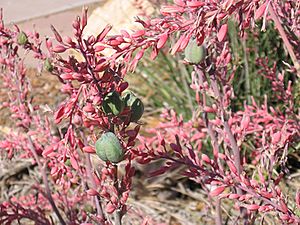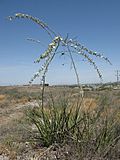False yucca facts for kids
Quick facts for kids False yucca |
|
|---|---|
 |
|
| Hesperaloe parviflora | |
| Scientific classification |
|
| Kingdom: | Plantae |
| Clade: | Tracheophytes |
| Clade: | Angiosperms |
| Clade: | Monocots |
| Order: | Asparagales |
| Family: | Asparagaceae |
| Subfamily: | Agavoideae |
| Genus: | Hesperaloe Engelm. |
Hesperaloe (also called false yucca) is a group of flowering plants. They belong to the Asparagaceae family, which also includes plants like asparagus.
These plants look a bit like yucca plants. They are perennials, meaning they live for many years. Their long, thin leaves grow in a circle at the base. Their flowers grow on tall stalks. These stalks can be branched (called panicles) or unbranched (called racemes).
Hesperaloe plants grow naturally in dry areas. You can find them in Texas, United States, and parts of Mexico. People sometimes grow them in gardens. They are good ornamental plants for dry climates. This is because they are xerophytes, meaning they need very little water.
What's in a Name?
The name Hesperaloe comes from two words. "Hesperos" is a Greek word. It means "western." The second part, "aloe," is because these plants look like aloe plants. So, the name basically means "western aloe."
Types of Hesperaloe
There are several accepted types, or species, of Hesperaloe. Here are some of them:
| Image | Scientific Name | Where it Grows |
|---|---|---|
 |
Hesperaloe campanulata | Nuevo León, Mexico |
 |
Hesperaloe chiangii | San Luis Potosí, Mexico |
 |
Hesperaloe engelmannii | Texas, USA |
 |
Hesperaloe funifera | Coahuila, Nuevo León, Sonora, San Luis Potosí (Mexico), Texas (USA) |
 |
Hesperaloe malacophylla | Tamaulipas, Mexico |
 |
Hesperaloe nocturna | Sonora, Mexico |
 |
Hesperaloe parviflora – Red Yucca | Coahuila (Mexico), Texas (USA) |
| Hesperaloe tenuifolia | Sonora, Mexico |
See also
 In Spanish: Hesperaloe para niños
In Spanish: Hesperaloe para niños

